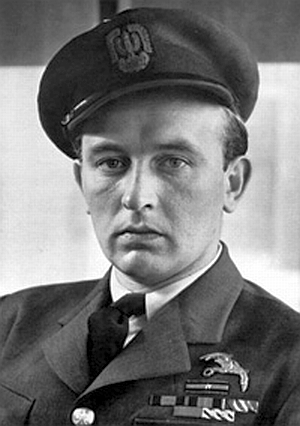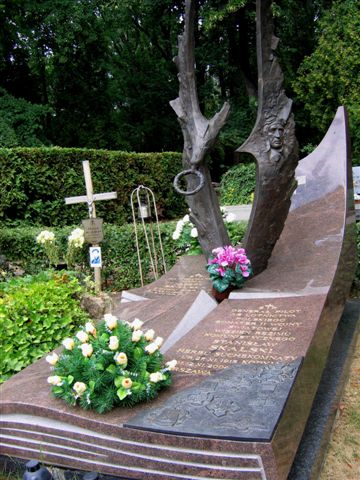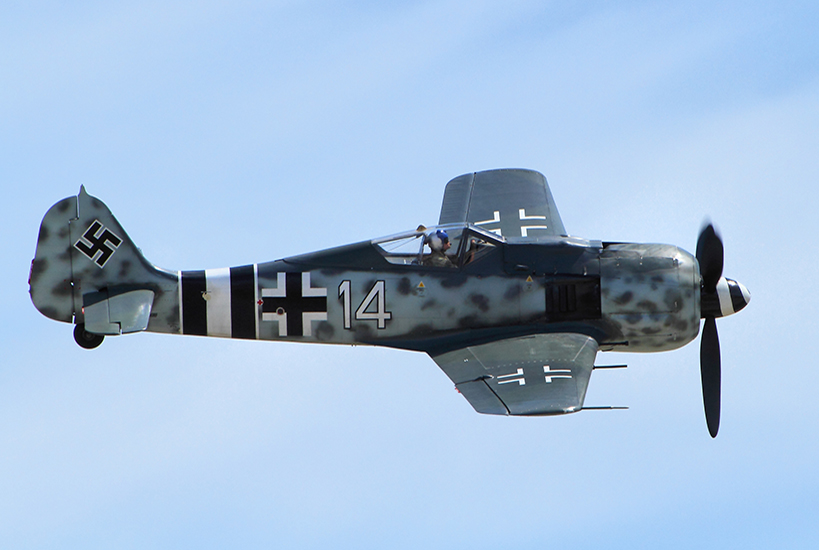Skalski, Stanislaw
- Date of birth:
- November 27th, 1915 (Kodyma/Ukraine, Russian Empire)
- Date of death:
- November 12th, 2004 (Warsaw, Poland)
- Buried on:
- Cmentarz Wojskowy
- Service number:
- 76710
- Nationality:
- Polish
Biography
Brigadier General Stanislaw Skalski was born on October 27 1915 at the village of Kodyn, near Odessa. After the Russian Revolution of 1917, his father sent him and his mother to Zbaraz, near Lvov.
After attending school in Dubno, Stanislaw learnt to fly gliders in 1934, and the following year he qualified on powered aircraft. He now decided to become a military pilot, and entered the cadet school at Deblin in 1936; he completed his training in October 1938, graduating as an officer. Skalski was assigned to the 4th Air Regiment at Torun, where he joined No 142 Eskadra, the "Flying Ducks", to fly PZL fighters. Following the German invasion of Poland on September 1 1939, Skalski and his squadron were in action immediately. He claimed his first victory on the opening day, and by the fifth day he had destroyed four German bombers, to become the only Polish ace of the short campaign. As Polish resistance collapsed, the remnants of his squadron escaped to Romania. He eventually made his way to the Mediterranean, where he boarded a boat for England, arriving in January 1940 and was commissioned in the RAF. After a period of inactivity with a fighter squadron in the north of England, he joined No 501 Squadron at the height of the Battle of Britain in August 1940. Flying Hurricanes from Gravesend, the squadron had seen much action, and Skalski soon claimed his first victory when he shot down a Heinkel on August 30. The next day he shot down a Me109 fighter and destroyed two more on September 2. Three days later he took off to attack a large bomber force approaching Kent, and sent a Heinkel down in flames before attacking a Me109. After hitting the German fighter, he watched the pilot bale out before climbing to attack another Me109, which he destroyed over Canterbury. As he turned away, Skalski was himself attacked and his Hurricane set on fire. He baled out and was admitted to Herne Bay hospital, where he remained for six weeks receiving treatment for serious burns. Anxious to return to combat, he discharged himself at the end of October and returned to No 501.
In March 1941 he was posted to No 306 (Torun) Polish squadron flying Spitfires, and during the summer of 1941 he was to claim another five victories on sweeps over northern France. In March 1942 he joined No 316 Squadron and soon accounted for a Fw190 fighter. He was promoted to squadron leader and given command of No 317 Squadron, which he led during the combined operations at Dieppe when his pilots destroyed seven German aircraft.
After two years constant fighting, Skalski was rested in November 1942, when he became the chief flying instructor at a Spitfire training unit. Determined to return to a fighting unit, he became leader of the newly-created Polish Fighting Team (PFT) of volunteers in January 1943. Popularly known as "Skalski's Circus", the elite team numbered 15 of the best Polish fighter pilots who were attached to No 145 Squadron, flying from Bu Grara in the Western Desert. By May 13, when the final German forces in Tunisia surrendered, his Polish pilots had destroyed 30 enemy aircraft. In July 1943, Skalski took command of No 601 Squadron at Luqa, Malta, shortly before moving to Sicily. He was only the second Pole to be given command of a RAF squadron. In October, he was promoted to be the Wing Leader of No 131 Polish Wing at Northolt. In April 1944 he moved to command No 133 Wing, which had recently re-equipped with the Mustang fighter.
Skalski led his three squadrons on long-range bomber escort missions, often escorting bombers of the USAAF to targets as far as Hamburg. Then, with D-Day imminent, the squadrons began dive-bombing sorties against targets in northern France. On June 24 he chased two Me109's over Rouen, causing them to collide without firing a shot. They were his final claims, and he ended the war as Poland's highest-scoring fighter pilot. In September his operational flying career was over. At the end of the war Skalski was offered a commission in the RAF, but he decided to return to Poland in June 1947. Initially, he served at the headquarters of the Soviet-dominated Polish Air Force, but, following increasing tension between the Soviet Union and the Western Powers, he was arrested in June 1948 and charged with espionage and treason - a fate that befell many of his ex-RAF Polish colleagues. In 1949, after a series of cruel interrogations, he was condemned to death and spent the next six years awaiting execution. Eventually, his sentence was commuted to life imprisonment, and he was finally released in 1956 after eight years in prison.
On his release, Skalski was re-admitted to the Air Force, an offer he accepted with some hesitation. He flew the Soviet-built MiG fighters, and in 1972 he ended a distinguished career with the rank of general. He became the President of the Polish Aero Club before retiring to Warsaw, where he led a lonely life.
Skalski was remembered as a great individualist and man of action. One of his pilots described him as "an eagle in the air, he was a great commander and a brilliant leader and we would follow him to hell if necessary". On the ground he could be stubborn, and he held strong opinions which did not always accord with those of his superiors; but his fighting qualities and courage were never in doubt. He made numerous visits to England, and attended the unveiling in June 1994 of a memorial to No 133 Wing at the site of their former airfield at Coolham in Sussex. In September 2000, he joined fellow veterans at the National Memorial to "The Few" at Capel le Ferne to commemorate the 60th Anniversary of the Battle of Britain; he insisted on sitting with his surviving friends from No 501 Squadron.
Stanislaw Skalski died in Warsaw on November 12. He was unmarried.
Do you have more information about this person? Inform us!
- Period:
- Second World War (1939-1945)
- Awarded on:
- December 1940
- Period:
- Second World War (1939-1945)
- Awarded on:
- September 1941
- Period:
- Second World War (1939-1945)
- Awarded on:
- September 1941
- Period:
- Second World War (1939-1945)
- Awarded on:
- September 1941
- Period:
- Second World War (1939-1945)
- Awarded on:
- September 1941
- Period:
- Second World War (1939-1945)
- Rank:
- Squadron Leader
- Unit:
- No. 317 (Wilno) Squadron, Royal Air Force
- Awarded on:
- September 10th, 1942
"This officer has been engaged on operational flying since 1940 and has participated in 79 sorties over enemy territory. Squadron Leader Skakski led his squadron in the combined operations at Dieppe on 19th August 1942, when the squadron destroyed seven enemy aircraft without loss to themselves. This achievement reflects the greatest credit on this officer's excellent leadership and the confidence he has inspired in those under his command. He has personally destroyed eleven enemy aircraft, probably destroyed four and damaged two others."
Second DFC awarded as a bar for on the ribbon of the first DFC.
- Period:
- Second World War (1939-1945)
- Rank:
- Squadron Leader
- Unit:
- No. 145 Squadron, Royal Air Force
- Awarded on:
- July 1st, 1943
Third DFC awarded as second bar for on the ribbon of the first DFC.
- Period:
- Second World War (1939-1945)
- Awarded on:
- May 1944
- Period:
- Second World War (1939-1945)
- Rank:
- Wing Commander
- Unit:
- No. 133 (Polish) Wing, Royal Air Force
- Awarded on:
- August 1944
Permission to accept this award was granted by the Polish President Władysław Raczkiewicz on the 26th May 1945.
- Period:
- Second World War (1939-1945)
- Period:
- Second World War (1939-1945)
- Period:
- Second World War (1939-1945)
- Period:
- Second World War (1939-1945)
- Period:
- Second World War (1939-1945)
- Period:
- Second World War (1939-1945)
- Period:
- Second World War (1939-1945)
- Period:
- Second World War (1939-1945)
- Period:
- Second World War (1939-1945)
- Period:
- Second World War (1939-1945)
- Period:
- Second World War (1939-1945)
- Period:
- Second World War (1939-1945)





















